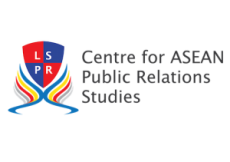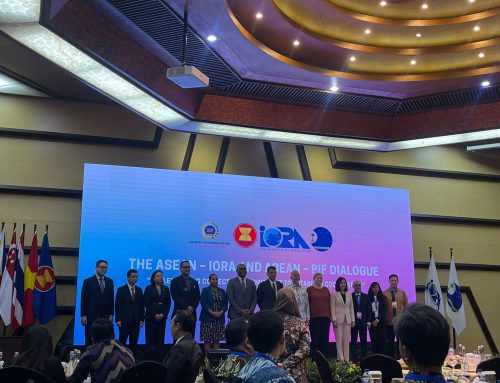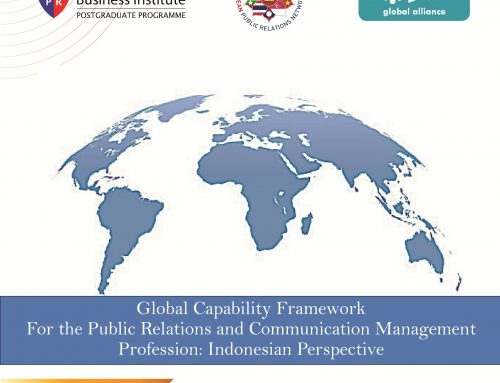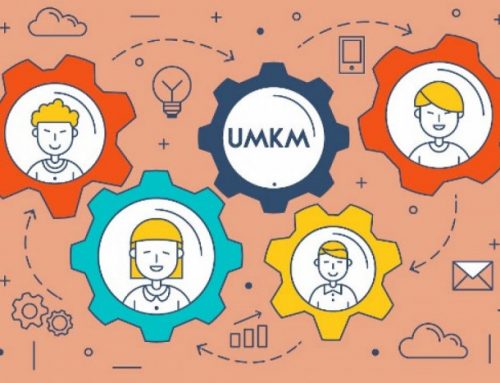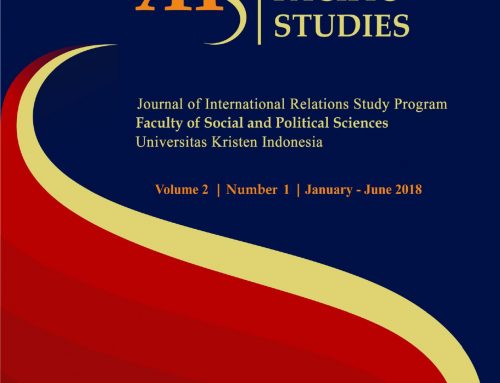Communication Strategy For SMEs in ASEAN:
Ready to Compete Regionally and Globally
By :
Yuliana Riana P, MM
Head of Centre For ASEAN Public Relations Studies at LSPR-Jakarta
THE NEW CHAPTER OF ASEAN
On 8 August 2017, ASEAN goes 50 year old, and to date, ASEAN has entered a developing phase as ASEAN Community where it has chosen to be an integrated region. This integration was formed into three cooperation pillars amongst ASEAN member: ASEAN Political-Security Community, ASEAN Economic Community, and ASEAN Socio-Cultural Community. Since 31 December 2015, ASEAN Community is no longer a vision but it already an applied reality. Being aware of the importance of this momentum, ASEAN Ministers Retreat (AMM) in Vientiane, Laos in 26 – 27 February 2016, has chosen a new theme: “Turning Vision into Reality for a Dynamic ASEAN Community”. This marks the implementation of ASEAN Community 2025 Vision, the improvement of ASEAN centralisation and external relations of ASEAN among the growing regional.
As per today, ASEAN is competitively new economy strength. First, the ten member countries of ASEAN have become a powerful economy in the world. This can be seen with GDP growth of ASEAN member countries as that is presented as follows:
ASEAN Member Countries Gross Domestic Product
In 2015 – 2016
| Rank | Country | Population in millions |
GDP Nominal millions of USD (2016) |
GDP Nominal millions of USD (2015) |
| 1 | INDONESIA | 260,581 | 940,953 | 861,934 |
| 2 | THAILAND | 68,147 | 390,592 | 395,282 |
| 3 | PHILIPPINES | 103,701 | 311,687 | 291,965 |
| 4 | MALAYSIA | 31,973 | 302,748 | 296,218 |
| 5 | SINGAPORE | 5,607 | 296,642 | 292,739 |
| 6 | VIETNAM | 92,700 | 205,860 | 193,599 |
| 7 | MYANMAR | 54,363 | 68,277 | 64,866 |
| 8 | CAMBODIA | 15,626 | 19,476 | 16,778 |
| 9 | LAOS | 6,492 | 13,761 | 11,997 |
| 10 | BRUNEI | 417 | 10,458 | 17,105 |
Source: International Monetary Fund’s, 2016 and The World Bank, 2015
The Second, ASEAN is home to more than 600 million people so ASEAN have big ASEAN market and third, ASEAN is home to many globally companies. in 2006, By 2013, that number has risen to 74, added by 227 world’s companies with more than $1 billion revenues, or 3% of the world’s total. (Vinayak HV, Fraser Thompson, and Oliver Tonby of McKinsey, 2014). The fourth is ASEAN’s highly competitiveness is nonetheless a result of participation and support of dialogue partners. Until today, ASEAN have ten dialogue partners such as: Australia, Canada, China, European Union, India, Japan, New Zealand, Russia, Republic of Korea (ROK) and the United States. ASEAN partnership with these countries has proven that ASEAN economical growth has increased significantly. For examples; China was the first dialogue partner to start negotiations with ASEAN on establishing Free Trade Area (FTA) of developing countries. China has been ASEAN’s largest trading partner since 2009, while ASEAN has been the third-largest trading partner of China since 2011. Another dialogue partners, the EU is the largest investor in ASEAN countries for 22% of total FDI inflows in the region. Through the realisation of ASEAN Economic Community, ASEAN is potentially a market and production basis, a valuable region, owns an equal economical growth, as well as a world-integrated economy.
One of the factors to support ASEAN Economic Community is through ASEAN Connectivity. ASEAN Connectivity is based on three main dimensions: Physical Connectivity, Institutional Connectivity, and People to people Connectivity. The objective of ASEAN Connectivity is to escalate the lives of citizens of ASEAN by: providing more opportunities, improving economical and social development, and uniting the ten countries as a combined power. Therefore, ASEAN Connectivity enables ASEAN potentials to be more realistic and impactful, which then promoting ASEAN to compete better in global environment.
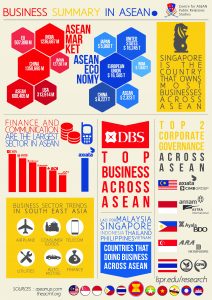
BUSINESS SUMMARY IN ASEAN
Source: Centre For ASEAN Public Relations Studies, LSPR-Jakarta (2015)
OPPORTUNITIES AND CHALLENGES FOR SMEs in THE ERA OF ASEAN ECONOMIC COMMUNITY
AEC have key characteristics is single market and production base, highly competitive economic region, proportional economic growth and a fully integrated region with the world’s economy. AEC an attempt ASEAN leaders in response to the ever-changing dynamics of the world.
Some conditions are a factor for the birth of AEC is 1) The effects of economic crisis experienced by the countries in Southeast Asia in 1997. The weakening of the currency some of the member states of ASEAN such as Indonesia, Thailand, the Philippines and Malaysia to the value of the US dollar led to the economic growth slowdown; 2) China and India into a new world economic powers. Political and economic reform in China and India to encourage global businesses to invest in both countries. Wage labor is cheap and government policies that open make the investment and economic growth in China and India continue to increase. This of course has implications for the member states of ASEAN for foreign investment that was originally invested in ASEAN started moving into China and India.
In response to these conditions, the ASEAN leaders agreed to speak a solution to transform ASEAN into a region fully integrated and competitive so as to attract the global economic actors to re-invest in order to create wealth and prosperity for ASEAN. Therefore, ASEAN leaders signed the ASEAN Vision 2020 document in the Conference ASEAN Summit on December 1997 in Kuala Lumpur, Malaysia. Furthermore, in October 2003, the ASEAN leaders agreed in the Bali Concord II, ASEAN High Level Conference 9th in Bali, Indonesia. Bali Concord II aims to promote integration through the realization of the ASEAN Community which has three pillars, namely security pillar, the pillar of economic and socio-cultural pillars.
According A Blueprint for Growth AEC 2015: Progress and Key Achievements, AEC have the four pillars . The first AEC pillar seeks to create a single market and production base through free flow of good, services, investment, skilled labor and free flow of capital. The second pillar helps to create a business-friendly and innovation-supporting regional environment. The third pillar seeks to achieve sustainable and balanced growth and development through equitable economic development. This is done through creative initiatives that encourage SMEs to participate in regional and global value-chains, and focused efforts to build the capacity of the ASEAN’s newer member states to ensure their effective integration into the economic community. The last pillar of AEC seeks to achieve integration into global economy. This is pursued through a coherent approach towards external economic relations, including through free trade areas and comprehensive economic partnership agreements, and enhanced participation in global supply network.
In 2015 AEC Blueprint, particularly the third pillar, the ASEAN leaders actively support and visible on SMEs in order to further enhance the competitiveness of SMEs and durability participating ASEAN to build economic strength.
Why? Because SMEs are the backbone of the ASEAN economy. In 2014, the number of SMEs reached 88,8 – 99,9% in the ASEAN. SMEs also contribute to employment up to 51-97% in each of ASEAN member country. SMEs commits to export activity around 10 -30%, and approximately 30-60% of the GDP.
The Diversity of SME definitions in ASEAN
(based on average number of employees)
| ASEAN Countries | Definitions |
| Indonesia | Fewer than 100 employees |
| Cambodia | Firms that employ between 11 and 50 employees |
| Lao PDR | Small enterprises are those having an annual average number of employees not exceeding 19 person |
| Philippines | Fewer than 200 employees |
| Vietnam | Fewer than 300 employees |
Source: SMEs in ASIA AND THE PASIFIC
Strengthening SMEs is one of the important elements in the AEC Blueprint 2015, particularly related to the pillars of proportional economic development which highlight the commitment to reducing the development gap within the region. AEC Blueprint 2025 re-emphasize the role of SMEs as the backbone of the economy of ASEAN for preparing a variety of programs aimed at improving the competitiveness and resilience of SMEs to be able to benefit from ASEAN economic integration. This was confirmed at the 27th ASEAN Summit in Kuala Lumpur, where ASEAN adopted the Strategic Action Plan for SME Development (SAPSMED) 2016-2025 with a vision Globally Competitive and Innovative SME. Looking at the various challenges faced by SME in ASEAN, the ASEAN Economic Ministers in 2015 has adopted the ASEAN Strategic Action Plan for 2016-2025 SME Development (SMED SAP 2025). SAP SMED 2025 is targeted at: (1) increased productivity; (2) technology and innovation; (3) access to finance; (4) access to markets and internationalization; (5) policies and regulations; and (6) entrepreneurship and human resource capacity.
The presence of SAP SMED in 2025 was also a form of response to the completion of the various problems faced by SMEs in ASEAN. ASEAN Working Group in collaboration with the Economic Research Institute for ASEAN and East Asia (ERIA) and Organization for Economic Research Cooperation and Development (OECD) conduct research on the importance of SMEs in ASEAN, and resulted the eight dimensions measured policy. Eight SMEs policy dimensions include: First, the institutional framework; Second, access to support services; Third, start a business that is faster and cheaper and better regulation for SMEs; Fourth, access to finance. Fifth, technology and technology transfer; Sixth, international market expansion; Seventh, education and entrepreneurship training and Eight, the empowerment of SME policy.
Based on these results, Singapore is the highest Value of Small and Medium Enterprises Policy Index achiever in ASEAN with an index value of 5.4 and followed by Malaysia with an index value 4,7. This study shows that the development of various SMEs regulations are still need to be improved in other ASEAN member states in order to create high SMEs competitiveness within ASEAN region.
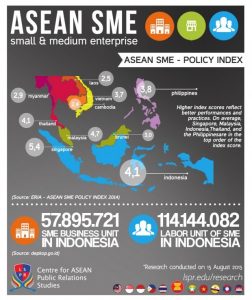
ASEAN SMEs Infographic
Source: Centre For ASEAN Public Relation Studies, 2015
The presence of AEC will bring many opportunities and challenges, depending on the readiness of businesses in the face. As a free trade area, more than 70 percent of products made in ASEAN will not be subject to tariffs, aka zero tariffs.
This makes the free movement of goods and services which are expected to lower the price of raw material and production costs in ASEAN up to 10-20 percent. Unfortunately, this tariff reduction is in fact not been widely used by SMEs. According to estimates only about 20 to 25 percent of Indonesian companies that take advantage of the preferential tariff reductions (common effective preferential tariff / CEPT) applicable in AFTA or AEC
In addition, SMEs must be able to adapt to the overall business environment, ease of access to finance, access to markets, and productivity and efficiency. Not to mention the special micro enterprise that has the potential to grow from a small or medium-sized businesses are still experiencing barriers to connect with financial institutions because they do not have the financial documentation and records, there is no banking relationships, and lack of financial literacy. SME credit information availability, availability or lack of guaranteed credit, SME financing program mismatch, adds to the problem.
Meanwhile, banks must also be able to bridge a better access to finance of SMEs. It can be achieved through improved risk management skills and financial institutions better understand the needs of the sector, thus enhancing their ability to manage SME financing program.
The importance of improving the competitiveness of SMEs and durability fully realized by the leaders of ASEAN and has been mandated in the AEC Blueprint 2015 has been reinforced by the presence of the AEC Blueprint, 2025. Therefore, in order to achieve these objectives need to be implemented strategic measures taken in order enhance the competitiveness of SMEs and durability both regionally and globally ASEAN. Here are the strategic steps set out in the AEC Blueprint “Forging Ahead Together”:
- Promote productivity, technology and innovation through measures to enhance SMEs productivity by understanding key trends in productivity; build industry clusters through industrial linkages, promote technology and build capabilities to foster industry clustering; as well as promote innovation as a key competitive advantage through technology usage and its application to business and business-academia linkages.
- Increase access to finance by developing and enhancing the institutional framework in respect of improving understanding and strengthening traditional financing infrastructure as well as the policy environment and measures that foster alternative and non-traditional financing; promote financial inclusion and literacy and the ability of SMEs to be better engaged in the financial systems; and enhance tax and other incentive schemes;
- Enhance market access and internationalization by extending and developing support schemes for market access and integration into the global supply chains including promoting partnership with multinational corporations and large enterprises to increase market access and opportunities; promote use of e-Commerce; and enhancing measures to promote exports through mechanism such as export clinics and advisory service;
- Enhance SMEs policy and regulatory environment that promotes intra and inter-governmental cooperation and coordination mechanisms; involvement of SMEs in the decision-making process to enable better representation of SMEs interests; provide support to micro enterprises in the informal sector and their integration; and streamline processes involved in obtaining of permits and business registrations to enable less costly and faster business formation and
- Promote entrepreneurship and human capital development by creating a more conducive environment for entrepreneurship through the ASEAN On-line Academy; and enhancing human capital development for SMEs, in particular youth and women.
The implementation of Blueprint ASEAN 2025 to improve the competitiveness and creativity SMEs already on progress. One of them, ASEAN SME Academy was launched in May 31st 2016 during the 1st Meeting of ASEAN Coordinating Committee on MSME in Singapore. It is a collaborative initiative between the US-ASEAN. The ASEAN SME Academy is one-stop, open-access gateway that provides business information and training resources to support ASEAN SMEs. The ASEAN SME Academy can be accessed at http://www.asean-sme-academy.org/
Support for SMEs is also given by ASEAN dialogue partners. For examples, Japan significant contributions to capacity building for ASEAN SMEs, whereas China and Canada has been partnership for SMEs development. United States of America also have supported WeCreate centers in Cambodia and Vietnam that launch women-owned start-ups.
COMMUNICATION STRATEGY FOR SMEs in ASEAN
Communication factor is very important in running a business because it will create a strong emotional bond with the consumer (the target market). The use of communications technology also helps SMEs gain market information is complete and accurate can be used by SMEs to plan their business properly, for example: (1) a product design that consumers preferred, (2) determine the competitive prices on the market, (3) knowing markets that will be addressed, and many other benefits. Another challenge is the lack of communication in promoting and exposing SMEs in ASEAN despite the SMEs product excellence and company profile, especially the ones that aim consumers both at home and abroad. Therefore, the question that needs to be answered is to what extent does communications strategy especially use public relations tactic in helping to improve the competitiveness of SMEs in ASEAN and Global?
Public Relations build mutually has a particularly important role in building awareness and educating the SMEs intended target market. Potential public relations tactic are:
- Brand Storytelling in ASEAN
The target market of SMEs tend to be uninterested in the products of SMEs due to various factors such as lack of information about the product so that the audiences are unaware. The Brand Storytelling in ASEAN aims to highlight the uniqueness and superiority of the product through the stories that can inspire the audience so they can share a story about product. Media to be utilized by SMEs in ASEAN Brand Storytelling is Internet. Communicating via internet in various platforms, such as social media, website and email, is the right choice considering the target of SMEs market is in regional and global. The best promotion through Brand Storytelling in ASEAN submitted by the public have a strong impact to build product awareness. In addition, the use of communication via the Internet can overcome the constraints of distance or intensity of communication. Communication is very important in running a business because it will create a strong emotional bond with the target market.
For example is one of startup business in Indonesia is Go-Jek Indonesia (Go-Jek) that provide various services, including transport and home delivery of food. Go-jek have program Go-Jek Hero Day. The program aims to help improve the welfare of Go-Jek driver partners through access to financial services, auto installment affordable, discounts for daily needs, access to business opportunities to increase family income, as well as training to drive. When launching the program then the driver took the family to pose and publish through social media and so that day has been created the best promotion through Brand Storytelling “Go-Jek Hero Day”.
- Communicating by Social Media
SMEs can communicate using social media to reach potential markets in the region and globally. Social media is the right choice because of cost and the current social media usage continues to increase in many ASEAN member countries. Social media user in ASEAN is a large market opportunity for SMEs and should be utilized to the optimum.
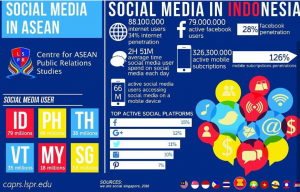
SOCIAL MEDIA IN ASEAN
Source: Centre For ASEAN Public Relation Studies, 2016
The presence of the Internet has changed the map of communication especially for millennia generation who prefer to get a variety of information through various digital platforms such as social media. Therefore, it is expected to SMEs in ASEAN can use social media to communicate their products. The benefits that can be gained by SMEs when using social media in communicating their products in addition to broader coverage is viewers can join the campaign spread to many people. Therefore, it takes creativity for owners of SMEs to make an interesting campaign.
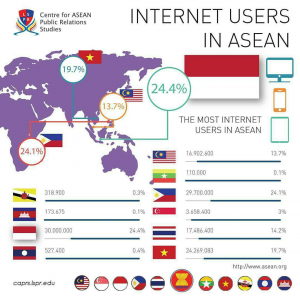
INTERNET USERS IN ASEAN
Source: Centre For ASEAN Public Relation Studies, 2016
- Key Opinion Leader (KOL) for SMEs in ASEAN
Digital connectivity in ASEAN countries has grown rapidly therefore the use of KOL to influence public opinion to buy the products of SMEs is an appropriate options strategy. KOL can be chosen from a successful SMEs in ASEAN.
- ASEAN Direct Relations
ASEAN Direct Relations is strategy to communicate the SMEs products in ASEAN and global. ASEAN Direct Relations Direct use traditional way of Public Relations like media gathering and showcase to communicate the products of SMEs in order to get a good awareness. In addition to media gathering and showcase creating awareness are complemented by educating the target market so that they can comprehend the quality of SMEs products very well. Communications strategy is considered to be an appropriate step for SMEs because through media gathering, the SMEs will gain support from the media to communicate its products through mass media. Additionally, event can be done as a meeting point between producers and SMEs target market, as well as an opportunity to expand its network with investors. Nevertheless, the role of government to facilitate SME showcase in ASEAN and global products is also necessary.
As an example is the initiative from Malaysia organized ASEAN SME Showcase and Conference 2015. This event was held on 26th to 28th of May at Kuala Lumpur, Malaysia and themed One Business, One Community. The aims of this events is to strengthen cooperation and economic integration among ASEAN SMEs. Thus, SMEs are able to highlight themselves, as well as, their products and services with potential investors and media partners.
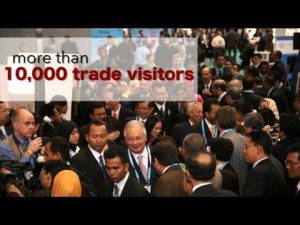
ASEAN SME Showcase and Conference 2015 at Kuala Lumpur, Malaysia
Source: www.youtube, 2015
- ASEAN SME Service Center.
ASEAN SME Service Web Portal is action plan for development SMEs in ASEAN. The aim of ASEAN SME Service Web Portal providing information crucial for SMEs to penetrate regional and international market. ASEAN SME Service Web Portal can be accessed through http://www.aseansme.org The link become a meeting place in digital between enterprises, traders, suppliers, manufacturers and consumers within ASEAN member states and trade partners, so SMEs are able to take advantage of the trade and investment opportunities and benefits from regional economic integration.
- Promoting SMEs Through e-Commerce
In the globalized world of interconnected through information and communication technologies, e-Commerce presence to support SMEs to improve competitiveness. As an example, E-Commerce Lazada Indonesia bring Small and Medium Enterprises (SMEs) from Indonesia’s global expansion starting with Malaysia products to market. Lazada Indonesia start with the Malaysian market to bring SMEs go global. Malaysia selected as the first market for SMEs to global expansion due to cultural and geographical closeness. Bring SMEs go global action is in large umbrella campaign Made in Indonesia, from Indonesia to the World.
- To Create Corporate Identity in SMEs
The presence of AEC requires SMEs to become more competitive and creative through quality products and superior as well as typical. However it is also important for SMEs to be able to manage identity which is reflected through the company’s name and logo and other views that became the beginning of the rise of public awareness of the presence of a SMEs. Therefore, the importance of identity presented by SMEs acceptable and recognizable by people in ASEAN. As the saying goes “Unknown, unloved.”
AEC 2015 to bring a very significant impact for the development of SMEs. AEC provides an opportunity for SMEs to become a major player in the ASEAN market and allows to integrate within production network of regional and global market. Entering ASEAN 50th also provides a golden opportunity for the removal of barriers and encouragement of SMEs development for more competitive. SMEs in ASEAN ready to compete regionally and globally.
IT’S ASEAN Time.
End
Sources:
ASEAN STRATEGIC ACTION PLAN FOR SME DEVELOPMENT 2016 – 2025, Jakarta: ASEAN Secretariat, November, 2015
https://www.laotiantimes.com/2016/09/09/asean-dialogue-partners-agree-on-future-direction/
https://www.smecorp.gov.my/images/pdf/SAP-SMED-Final.pdf
ASEAN 2025: Forging Ahead Together
Jakarta: ASEAN Secretariat, November, 2015
SMEs in ASIA AND THE PASIFIC http://www.unescap.org/sites/SMEs/ASIA/AND/THE/PACIFIC.pdf
Mckinsey & Company, Understanding ASEAN: Seven things you need to know, 2014 | by Vinayak HV, Fraser Thompson, and Oliver Tonby
Majalah Masyarakat ASEAN Edisi 10/ Desember 2015, Jakarta: Directorat Jenderal Kerjasama ASEAN, Kementerian Luar Negeri, RI
Majalah Masyarakat ASEAN Edisi 11/Maret 2016, Jakarta: Directorat Jenderal Kerjasama ASEAN, Kementerian Luar Negeri, RI
Majalah Masyarakat ASEAN Edisi 13/September 2016, Jakarta: Directorat Jenderal Kerjasama ASEAN, Kementerian Luar Negeri, RI
